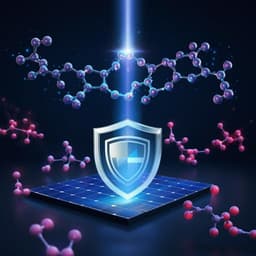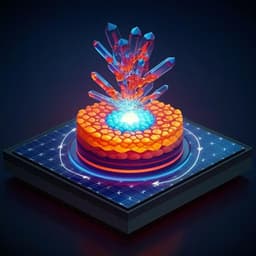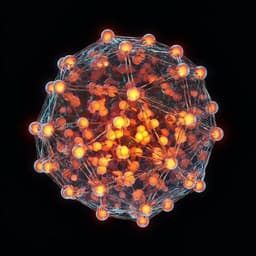
Engineering and Technology
Stable and sustainable perovskite solar modules by optimizing blade coating nickel oxide deposition over 15 × 15 cm² area
F. Jafarzadeh, L. A. Castriotta, et al.
Discover how Farshad Jafarzadeh and colleagues have tackled scalability issues in perovskite solar cells by introducing an innovative blade coating process. This method enhances the uniformity of films, achieving impressive efficiency while maintaining stability, paving the way for large-scale and sustainable solar energy solutions!
~3 min • Beginner • English
Introduction
The study addresses the challenge of scaling perovskite solar cells (PSCs) from laboratory-scale devices (>26% PCE) to industrially relevant large-area modules while maintaining stability and sustainability. Conventional small-area fabrication methods such as spin coating are material-inefficient and poorly scalable. The authors focus on printable, meniscus-based deposition techniques (blade coating and slot-die), which are compatible with ambient processing and roll-to-roll manufacturing, to reduce waste and enable high-throughput production. Inverted (p–i–n) architectures with nickel oxide (NiOx) as an inorganic hole transport layer (HTL) offer improved stability, photochemical robustness, and potential cost advantages compared to polymeric HTLs like PTAA. Despite high efficiencies in small-area devices with NiOx, performance typically drops when transitioning to large-area modules and to ambient-air deposition. This work aims to demonstrate a scalable, ambient-air blade-coating process for NiOx and perovskite layers on 15 × 15 cm² substrates, improve perovskite film quality through interface engineering with a self-assembled monolayer (SAM), and deliver efficient, stable large-area modules using a non-toxic solvent system.
Literature Review
The paper reviews scalable deposition routes for PSCs, highlighting printable methods (blade coating, slot-die, spray, screen printing, inkjet) versus non-printable ones (evaporation, chemical bath deposition). Meniscus coating (blade and slot-die) is emphasized for versatility and R2R compatibility. Prior studies have achieved high small-area efficiencies (up to ~23.6% with NiOx HTLs) but exhibit significant performance loss when moving to ambient-air processing and larger areas (e.g., ~20.7% for small-area devices and ~10.34% for ~3.7 cm² modules). Inverted architectures using NiOx offer advantages in stability and hysteresis reduction over PTAA-based devices. The authors position their work against this backdrop, aiming to close the gap between small-area performance and large-area, ambient-air fabricated modules using printable NiOx HTLs, while maintaining sustainability with green solvent systems.
Methodology
Substrates and overall approach: 15 × 15 cm² ITO-coated substrates were used. The process emphasized fully ambient-air doctor blading (meniscus coating) for NiOx, SAM, and perovskite layers, followed by thermal evaporation for top layers. The module interconnections (P1-P2-P3) were defined by UV ns laser scribing.
NiOx synthesis and blade-coating: An ink was prepared by dissolving 35.5 mg/ml (0.15 M) NiCl2·6H2O in 2-methoxyethanol with 20 µl/ml of 70% HNO3. The solution was heated at 75 °C for 2 h and remained stable for over a month. Doctor blading used a blade height of 100 µm, plate speed 5 mm/s, and 300 µl per pass. Films were annealed at 300 °C for 1 h in air to decompose and oxidize the precursor to NiOx. Four precursor concentrations were explored: reference 0.15 M, and dilutions 0.075 M (1:1), 0.050 M (1:2), and 0.037 M (1:3). Film thickness uniformity over ~14 × 14 cm² central area was mapped by ellipsometry at 225 points per sample. XPS (Ni 2p3/2) quantified oxidation states (Ni, NiO, NiOH, Ni2O3), and XRR probed large-area uniformity via electron density and roughness.
Interface engineering (SAM): A self-assembled monolayer, MeO-2PACz (2-(3,6-dimethoxy-9H-carbazol-9-yl)ethyl phosphonic acid), was prepared at 0.001 M (0.33 mg/ml) in anhydrous ethanol, stirred overnight, then sonicated at 40 °C for 10 min. Doctor blading was performed at 0.1 mg/ml in ethanol following literature methodology to form a SAM on NiOx prior to perovskite deposition.
Perovskite formulation and two-step blade-coating: A double-cation perovskite Cs0.15FA0.85Pb(I,Br)3 was deposited using a two-step, green-solvent approach. Step 1: PbI2:(FAI)0.3:(CsI)0.15 in DMSO with 0.25 mg/ml l-α-phosphatidylcholine additive was blade-coated with 100 µm gap at 2 mm/s on a 60 °C hotplate while using an air knife at 120 l/min to aid drying; drying regimes were tuned (ambient/partial/optimal/excessive). Step 2: 30 mg/ml FAI + 7.5 mg/ml FABr in 2-propanol was blade-coated with identical mechanical and thermal parameters. The wet film was exposed to an IR lamp at 60 °C for 1 min then annealed at 130 °C for 1 h to complete perovskite formation.
Top layers and interconnections: C60 (20 nm)/BCP (7 nm) were thermally evaporated as ETL/buffer. P2 scribing followed ETL evaporation. A 100 nm Cu back electrode was evaporated, and P3 scribing completed the series interconnection. All P1-P2-P3 were by UV ns laser.
Module layout optimization and geometry: On 15 × 15 cm² substrates, 22 cells were connected in series. Each cell width was 5 mm. Dead area (sum of P1-P2-P3 widths and safety margins) was 500 µm. Active area length was 11 cm, with ~2 cm margins along coating direction to accommodate start/stop transients of sheet-to-sheet coating. Aperture ratio (geometrical fill factor) was ~91%, aperture area ~121 cm².
Characterization: JV under AM1.5G using a class A simulator (ABET Sun 2000). NiOx thickness via spectroscopic ellipsometry (Semilab SE2000, 70°, 245–967 nm; optical model: Tauc-Lorentz + Drude). SEM (TESCAN MIRA) for morphology. XRR (Panalytical Empyrean, Cu Kα) in 0.610° < 2θ < 1.500° range; roughness extracted from Fresnel reflectivity. XPS in UHV (Al Kα, ~0.1 eV resolution) with Gaussian fitting; C 1s used for charge correction.
Stability testing: ISOS-T-1 thermal storage test at 85 °C in ambient air for 1000 h.
Key Findings
- Scalable ambient-air blade-coating of NiOx on 15 × 15 cm² ITO was achieved, enabling fully printable bottom stacks without spin coating.
- Optimal NiOx precursor concentration: 0.050 M (1:2 dilution). Selection based on trade-offs among thickness uniformity (ellipsometry mapping over 14 × 14 cm²), oxidation-state distribution (XPS), and electron density/roughness (XRR).
- NiOx thickness trends (ellipsometry): decreasing average thickness with increased dilution: 0.075 M → 42.2 nm; 0.050 M → 40.0 nm; 0.037 M → 36.2 nm. The 1:3 concentration showed edge thinning indicative of meniscus instability.
- XPS (Ni 2p3/2) showed increased higher oxidation state components (Ni2O3, Ni3+) at higher dilutions, with NiO (Ni2+) contribution decreasing; fitted peak centers and contributions are provided (e.g., for 1:2: Ni 6.8%, NiO 39.4%, NiOH 37.4%, Ni2O3 16.4%).
- XRR indicated that reference and 1:2 samples were most homogeneous; roughness estimates: ~4.5 nm (reference, 1:2). Roughness dispersion was larger for 1:1 (~2.5–4.5 nm) and 1:3 (~4.5–7.0 nm), consistent with thickness maps.
- Interface engineering with a MeO-2PACz SAM on NiOx eliminated perovskite pinholes and improved film uniformity on large area. Ellipsometry thickness map for perovskite showed an average ~570 nm thickness with a start–end gradient attributed to sheet-to-sheet blade dynamics.
- Large-area module performance (active area ~110 cm²; 22 cells in series): Champion PCE 12.6%, Isc 98.13 mA, Voc 22.3 V, FF 63.49%, with a hysteresis index of ~1.02 (reverse/forward PCE: 12.6%/12.37%). Pmax 1390 mW (reverse) and 1361 mW (forward). Jsc (reverse/forward) 19.67/19.02 mA cm⁻².
- Thermal stability (ISOS-T-1, 85 °C, air): modules retained ~84% of initial PCE after 1000 h.
- The modules fabricated in ambient air outperform previously reported printable, large-area perovskite modules with NiOx HTL in similar ambient conditions in terms of combined efficiency and stability.
Discussion
The work demonstrates that meniscus-based doctor blading in ambient air can produce uniform, functional NiOx HTLs over 15 × 15 cm² areas and, combined with SAM interface engineering, supports high-quality perovskite films suitable for large-area modules. Optimizing NiOx ink concentration to 0.050 M (1:2) balanced film uniformity, oxidation state composition, and density/roughness, enabling effective hole transport and film continuity over large substrates. The MeO-2PACz SAM addressed adhesion and interfacial trap issues at the NiOx/perovskite interface, suppressing pinhole formation and likely improving Voc and FF by mitigating interfacial recombination and facilitating hole extraction. The resulting module performance (12.6% PCE at 110 cm²) narrows the gap between small-area device efficiencies and scalable modules processed in ambient air while employing a non-toxic solvent system. The ISOS-T-1 thermal stability result (84% PCE retention after 1000 h at 85 °C) indicates promising long-term robustness of the NiOx/SAM interface and the printable stack, supporting the viability of ambient-processed, inorganic-HTL inverted modules for industrial scaling. The findings validate printable NiOx as a sustainable, stable HTL option and highlight that interface engineering is critical to realize uniform morphology and reliable module operation at scale.
Conclusion
The study establishes an ambient-air, blade-coated process for NiOx-based inverted perovskite solar modules on 15 × 15 cm² substrates using a non-toxic solvent system. By optimizing NiOx ink concentration (0.050 M) and integrating a MeO-2PACz SAM, the authors achieved uniform perovskite films and efficient large-area modules (110 cm² active area) with 12.6% PCE and 84% PCE retention after 1000 h of ISOS-T-1 thermal stress at 85 °C in air. These advances demonstrate a pathway toward scalable, sustainable, and stable PSC module manufacturing compatible with roll-to-roll processes. Future work should target further optimization of blade-coating dynamics to reduce thickness gradients, enhancement of NiOx conductivity and interfacial energetics, demonstration under broader operational stability protocols (e.g., ISOS-L/ISOS-D), and translation to continuous web-based production.
Limitations
- Thickness gradients in perovskite films arise from sheet-to-sheet blade start/stop dynamics; margins were required to define the active area, implying further process control is needed for uniformity across the full substrate.
- Trade-offs between NiOx film uniformity and thickness/oxidation state were observed at different precursor concentrations; highly dilute inks (1:3) suffered from meniscus instability and non-uniform edge thinning.
- Stability assessment focused on ISOS-T-1 thermal storage at 85 °C in air; other operational stress tests (light soaking, humidity cycling, thermal cycling) were not reported.
- The achieved module PCE (12.6%) remains below small-area device records, indicating remaining performance gaps to close during upscaling and ambient processing.
Related Publications
Explore these studies to deepen your understanding of the subject.







